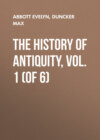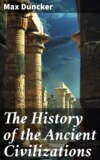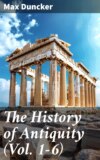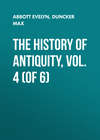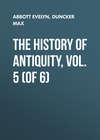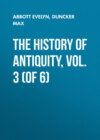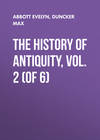Kitabı oku: «The History of Antiquity, Vol. 1 (of 6)», sayfa 21
As Baal and Moloch, the beneficent and the baneful powers, were united in Baal of Tyre, and in the form of Melkarth, so also was the goddess of reproduction, of birth, and procreation amalgamated with the warrior goddess, the maiden who brought death. It was this deity which in turn gave blessing and destruction, sensual enjoyment and war, birth and death. She inspired consuming sensual passion, and then caused death to overtake her lover, even if she did not slay him herself. Thus a Roman poet can put into the mouth of a Carthaginian the invocation, "Goddess Astarte, power of gods and men, life and safety, and again destruction, death, and dissolution."542 We find that the Venus of Tyre was called Astarte, that at Ashtaroth Karnaim, the ancient seat of the worship of the horned Astarte, the maiden with the horns of the moon, there was a sanctuary of Atargatis,543 and that fire-festivals were celebrated at Hierapolis in the sanctuary of Atargatis, which festivals belonged to Astarte; that the Urania, i. e. the birth-goddess, of Ascalon, Cyprus, and Cythera became an Aphrodite Areia, i. e. a warlike Aphrodite;544 that after Cinyras, the king of Byblus, whose daughters paid service to the goddess of Byblus with their bodies, Pygmalion became king, and he regarded with abhorrence the unchaste daughters of Cinyras, and worshipped the pure goddess of heaven, and taught how to appease her anger by human sacrifices.545 At Carthage a good goddess of the sky (bona cœlestis) was worshipped beside an evil one (inferna cœlestis). If human sacrifices were here burnt to the goddess Dido, just as the supposed foundress of Carthage is said to have burnt herself,546 her sister Anna, i. e. the charming one, was worshipped with cheerful rites. Other accounts mention that the two sisters Dido and Anna were one and the same goddess. Without doubt they are right. We saw that with the Babylonians the planet Venus, when rising, was the war-goddess Istar, and, when setting, she was Mylitta, the goddess of love (p. 270).
The relation of the Tyrian goddess Astarte to the moon has already been touched upon. As goddess of the moon, she was a changing, wandering deity. With the waning light of the moon she retired into the gloom of the west, the region of the setting sun; and on the disappearance of the goddess on the "bad evening," the Tyrians performed rites of mourning. As a "wandering goddess,"547 Astarte was called among the Phenicians Dido, i. e. the rover, and among the Westerns Europa, i. e. the dark one.548 With the retirement of the goddess was connected the legend how her destructive power was overcome; it showed how Astarte could be worshipped in Tyre as the wife of Melkarth, as Milkath (Melecheth, i. e. queen).549 The wandering sun-god went in search of the lost goddess. At length he found her in the remote distance, and loosed her girdle; the goddess surrendered herself to him, and sacred marriage changed the warlike goddess into the friendly deity favourable to procreation, Astarte into Ashera, Dido into Anna, Artemis or Athena into Atargatis. The "maiden of the sky" is now the wife of the god of Tyre, the Hera of the sky, the Ada (Athe) of the Syrians. From the embraces of Melkarth and Astarte, the sun-god and the moon-goddess, and the conquest of the cruel goddess of war, spring life, order, and law. The sacred marriage is said to have taken place in the West, at Samothrace, and further still, on the Cadmeia, the citadel of Cadmus,550 i. e. of the searching Melkarth, and finally beyond the pillars of the god, on the happy islands of the Western Sea, where all fruits of every kind grew spontaneously, especially the apples of life, the pomegranates of Ashera, the apples of the Hesperides, – the pledge of love, the symbol of life and light returning out of darkness. Here also Melkarth sank down to rest in the streams of the Western Sea, which his beams had warmed.551
The Syrians did not remain content with combining the beneficent and destructive powers into one form only, into Baal-Melkarth and Astarte-Ashera. While searching for the unity of the divine powers and the divine nature, they also combined the male and female deities into one figure, and the creative and receptive powers were amalgamated in one and the same form. As the combination of mighty heroic power with luxurious sensuality is the practical ideal of the East, so in theory also the highest union of the powers of nature and divine being, the amalgamation of male and female is attained by the same combination. When Astarte had become Ashera, and had surrendered herself to the god, the god in turn surrendered himself to the goddess. He plied female tasks, she carried the weapons. But even their nature became one, their forms were combined. Astarte and the Baal placed at her side became one deity. The male deity of the Moabites was Camos. When Mesha, king of Moab, took Nebo from the Israelites, he dedicated it to Ashtor-Camos.552 At Carthage Dido-Astarte was represented with the beard of Melkarth.553 At Paphos there was a standing image of the bearded Aphrodite, which was worshipped as a great divinity. It is this unification which lies at the root of the legends of Heracles (Melkarth) and Omphale (perhaps, mother554), of Semiramis and Sardanapalus. At certain festivals of Baal the priests and worshippers of the androgynous deity appeared in red transparent female garments, and were otherwise dressed as women, while the women were dressed as men, and carried swords and lances.555 The law of the Jews strictly forbids the erection of Astartes and pillars, the bringing of the hire of the harlot or the pay of the fornicator into the house of Jehovah, the tearing of the skin, or the cutting of the hair (which was customary among the Syrians in different ways as the symbol of the worship of certain deities), and insists that no eunuch shall come into the people of Jehovah, that no woman shall wear a man's clothes, and no man the clothes of a woman.556
Philo told us above (p. 355) that Eljon of Byblus, who was called the Highest, was slain in conflict with wild beasts, and was worshipped by after generations with libations and sacrifice. In Byblus, under the name Adonis (Adon, i. e. Lord), a god was worshipped, who was thought to have disappeared, or to have been carried off in the bloom of youth. Eljon and Adonis are one and the same form. When the maritime river named after this deity, the Adonis (now Nahr Ibrahim), near Byblus, began to run red in July (Thammuz), owing to the red earth washed down from the mountains, then it was believed that the beautiful Adonis was slain on Libanus by the savage boar of the war-god. With lamentations and cries the women sat in the shrine at Byblus; or lingered by the wayside lamenting the death of Adonis. They cut off their hair, tore their breasts, and cried out – Ailanu, ailanu (woe to us). Adonis was lost, and was now called Thammuz (the Departed).557 A time of lamentation was observed, during which his wooden image was washed and anointed, and laid upon a bier, which the priests carried about with their garments rent and beards shorn. But the god appeared again; he came to life again, as it seems, with the new spring. And as the lamentations for his death had been excessive, so also was the sensuality with which his return to life was celebrated.558 Hence we must assume that in Adonis was personified the vernal sun, the bloom of vegetation, which so soon begins to droop. If it was the boar of the war-god, i. e. of Moloch, which slew Adonis, as one account maintains, then in the minds of the Syrians the destructive sun-god, the glow of the midsummer sun which makes vegetation wither, was the cause of the death of Adonis.
Philo further told us of the two sons of the giants, the brothers Samemrumus and Usous, at Tyre (p. 354). The name Samemrumus means the High One of the Sky, a meaning which is clearly confirmed by the Greek attribute Hypsuranius. Hence Samemrumus was the god, the Baal of Tyre, Baal Melkarth. That Usous also was a god of Tyre is clear from the observation of Eusebius, that Usous, a man of little account, had been deified at Tyre beside Melicertes.559 Usous, who knew how to catch and destroy wild animals, and clad himself in their skins, the ancestor of hunters, reminds us of the Esau of Hebrew tradition. Compared in point of language the names of Usous and Esau coincide: "Usous" (Usov) means, like "Esav," the hairy one. Completely reversing the natural connection, Philo ascribes to Usous the erection of the pillars which belong to his brother, and represents the hunter as embarking on the earliest ship, whereas Samemrumus, the father of the fisherman, must have embarked on the first ship. We saw that the name Sidon means "fish-catchers" (p. 344). Hence the legends of the Phenicians carried back the origin of the Sidonians, to whom not only the city of Sidon but also Tyre belonged, to Baal Melkarth. From this god the tribe of the Sidonians, as it seems, pretended to have sprung. At a later period the mariners of the coast, i. e. the population of the harbour towns, looked down with scorn on the shepherds and hunters of the mountains, although they could not refuse to recognise the greater antiquity of this mode of life. Usous, therefore, must be regarded as the elder brother, the hunter of the mountains, like the Esau of the Hebrews, while the younger Melkarth takes up his abode in Tyre. That Usous is the firstborn is clear from Philo's remark, that Samemrumus rebelled against his brother. The contrast between the two brothers is marked by the statement of Eusebius, that Usous was of little account, more strongly than in Philo. From this we may perhaps conclude that Usous, the older god, was originally looked upon as a hostile power, as Baal Moloch; while in Samemrumus the friendly, helpful, beneficent power of the deity was personified as Baal Melkarth. An obscure trace of the contrast of the two gods is to be found also in the name Surmubel, i. e. Opponent of Baal, in Philo, which seems to belong to Baal Melkarth in opposition to Baal Moloch.560
The gods, whom the various cities of the Phenicians worshipped as their tutelary deities, were placed side by side as soon as the feeling of community in the cities became more lively, and intercourse between them more vigorous. Hence it came about that a common worship was also paid to these tutelary deities. Beside their significance in the natural and moral world, there resided from antiquity in certain deities peculiar relations to hunting and agriculture, and it was natural that as naval occupations, trade, and industry developed in the cities, the gods should be brought into relation to these spheres of activity also. In the same degree as it was felt that trade and commerce could only prosper amid internal peace and security in the cities, and under the protection of law and justice, the gods who maintained order in the world must become the protectors of order and law in the cities. In this feeling, and starting from conceptions of this kind, the priests of the Phenicians brought the gods of their cities into a connected system which, following the sacred number seven, included seven gods. The deities brought into this circle were known by the collective name Cabirim, i.e. the "Powerful," the "Great." Among the descendants of the "field" and the "husbandman," Philo has already mentioned Misor, i. e. Sydyk (justice). As powers ruling in justice, law, and equity, and maintaining order in the cities, the Cabiri are the children of Sydyk. The Greeks call them children of the sun-god, i. e. of Baal Samim; and if others connect the Cabiri with Ptah, the god of light among the Egyptians, the conclusion to be drawn is, that it was Baal Samim who, in his relation to the Cabiri, was denoted by the name of the Just, the supreme champion of justice. From the hunter and the fisher Philo derives Chusor, who discovered the working of iron; he calls him Hephæstus (p. 354). Chusor, so far as we can tell, was the foremost deity within the circle of the Cabiri. Phenician coins exhibit him with a leather apron, hammer, and tongs; the name seems to denote "arranger." He was the tutelary god of the life of the cities occupied in navigation and handicraft. Next to Chusor came a female deity, Chusarthis, also called Turo (Thorah, law), whom the Greeks call by the name Harmonia. As the same deity is also called the goddess of the moon, we cannot doubt that Chusarthis is Astarte, which is also sufficiently clear from other evidence; only in the new system the severe goddess was connected in a definite manner with the upholding of justice and preservation of law. Next to Astarte in the series of the Cabiri comes Baal Melkarth of Tyre, who is known to the Greeks under the name of Cadmus. He is regarded as the discoverer of mining and masonry and the inventor of writing. He searches for the lost Harmonia, and with her when found celebrates the sacred marriage. Hence Cadmus could be worshipped in this system as a life-awakening, phallic god, as well as the tutelar god of marriage. A peculiar reverence was enjoyed among the Cabiri by the deity who was added as an eighth to these seven; his name was Esmun, i. e. the Eighth. In this form it seems that the peculiarities of the seven gods were taken up and gathered together. At any rate in Carthage the temple of Esmun stood in the Byrsa, and on the highest part of it. In this temple the holiest relics of the city were preserved and the most important deliberations held. The Greeks call Esmun by the name of Asclepius, but also add that he was different from the Greek Asclepius. He was, it appears, a healing, i. e. an appeasing deity, like Jasion in the Cabiric mysteries of Samothrace. Esmun is also compared and confounded with Hermes, as with the Thoth of the Egyptians. Just as Thoth revealed the sacred books of the Egyptians, did Esmun reveal the sacred books of the Phenicians. Esmun was represented with a serpent in his hand as the serpent-holder (Ophiuchus), and his head as surrounded by eight rays. The forms of the eight tutelar gods were carved by the Phenicians on the prows of their ships; it was the Cabiri, as Philo told us, who discovered the ship. Even now Phenician coins exhibit the Cabiri in that dwarfed and distorted form in which the Phenicians loved to represent the nature and superhuman power of the gods.561
From the circumstance that the Greeks, when settling in Lemnos, Imbros, Samothrace, and Rhodes, found the worship of the Cabiri in existence, and adopted it, though not without certain alterations, we may conclude that the Cabiric system was established before the year 1000 B.C. In the tutelary gods of the sea-loving nation of the Phenicians the Greeks recognised and worshipped the deities favourable to mariners, and from this side they combined them with their own Dioscuri. On the other side the myth of Melkarth and Astarte, who were adopted into this circle of divinities, the myth of Melkarth, who discovers the lost moon-goddess in the land of gloom, and returns thence with her to new light and life, and who wakes to new life after the slumber of the winter, gave the Greeks an opportunity of connecting with the mysteries of the Cabiri those conceptions of the life after death, which grew up among them after the beginning of the sixth century.
When the great deities had been combined with the circle of the Cabiri, the subordinate spirits followed in their course. By degrees a scheme of thrice seven was reached, a scheme of twenty-one or rather twenty-two deities, since an eighth was added to the seven Cabiri. These, beginning with El, were arranged according to the twenty-two letters of the Phenician alphabet, and stood in a certain relation to them. From this number of deities, their various names, and the order of succession, various schemes of the origin of the gods were developed, and with the help of these genealogies certain systems of theogony and cosmogony were formed, of which the dislocated and confused fragments were found in Philo; and the chief of them I have given above. The wind Kolpia (p. 353) modern research would explain by Kol-pyah, i. e. "breath of the month;" Baau, the wife of this wind, by Bohu, i. e. Chaos, the Tohu-wa-Bohu of the Hebrews. The more abstract the potentialities with which these systems begin, the later we may assume their origin to be.
Like the Arabs, the Syrians originally worshipped their gods upon the mountains and in stones; then they erected pillars of wood and stone to them, and images, figures of bulls, or shapes combined from the forms of men and fish. They also erected statues male and female, or androgynous. At the great festivals the sacred tents and chests in which ancient symbols and tokens of the deities were preserved, or the images of the gods, were carried round in solemn procession.562 Of the festival in the temple of Atargatis, at Hierapolis, we have already spoken (p. 360); of the fire-festival which the Tyrians held in the spring, Lucian tells us: "They trim great trees, set them up in the court of the temple, and bring goats, sheep, birds, and other victims. These they fasten to the trees, and in addition, clothes and gold and silver jewellery. After these preliminaries they carry the images of the gods round the trees; the pyre is then kindled, and all consumed."563
As we may conclude from Lucian's account and from ruins, the temples were on a tolerably extensive scale. There were two or three courts, one after the other, either rectangular as at Paphus and Marathus, or oval, as at Malta and Gaulus, surrounded by strong walls, and furnished with pillars, altars, and pools of water. With these was connected a narrow and small shrine, containing the sacred stone or image. The tithes belonged to the gods. Every year, at the festival of Melkarth, in Tyre, an embassy appeared from Carthage which offered to the god of the mother city the tenth of the revenue of their state, and after great victories the Carthaginians probably sent a tenth of the spoil to the gods of Tyre.564 The number of priests was great; we often find hundreds engaged in a single sacrifice,565 and the ritual was complicated. The human sacrifices, mutilation, and prostitution, by which the Syrians sought to win the favour of their deities, we have already heard of. At a later time at all the great sanctuaries there were thousands of male and female servants beside the priests. The priests lived on the tithes, the temple lands, and the part which fell to them in the sacrifices. The ritual distinguished burnt offerings, offerings of purification, expiatory offerings, and offerings of the first fruits; besides animals and the firstlings of the field, sacrificial cakes were frequently offered. The bull was the most acceptable victim; cows were not sacrificed, nor the flesh eaten. Beside bulls, rams and he-goats, and of birds, the dove, the partridge, the quail, and the goose were offered. The animals were required to be pure, without blemish, of the male sex, and capable of procreation. To guard against the offering of unclean beasts, the priests of Hierapolis refused to sacrifice any but those bought from themselves.566 Two Phenician inscriptions of Massilia and Carthage have come down to us from the fourth century B.C., containing the edicts of the Carthaginian Suffetes about the part of the sacrifice belonging to the priests, the fee to be paid for the sacrifice, and finally the price of the victims purchased of the priests. The Carthaginian inscription lays down the rule that of a bull, a ram, or a goat, offered as a burnt-offering, the skin was to be the property of the priests and the inwards the property of the person presenting the victim. Moreover, of every victim offered, the cut and roasted flesh went to the priests. On the other hand, the inscription of Massilia gives the skin to those who present the victim (the law of the Hebrews also gives the skin of a burnt-offering to the man who offers the victim), but according to this decree the victims must be bought from the priests. For a bull ten shekels were to be paid to them, and though the tariff at Carthage lays upon the sacrificer a fee of only 2 sus for each head of fowl sacrificed, the inscription of Massilia raises the fee to 3/4 of a shekel and 2 sus.567
